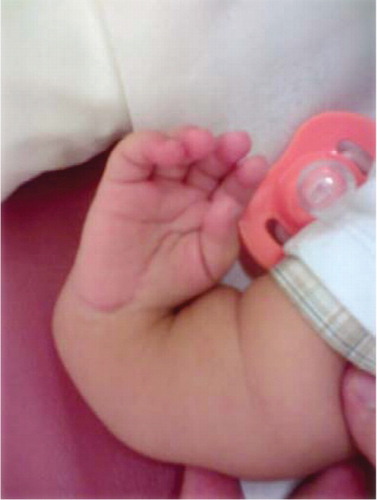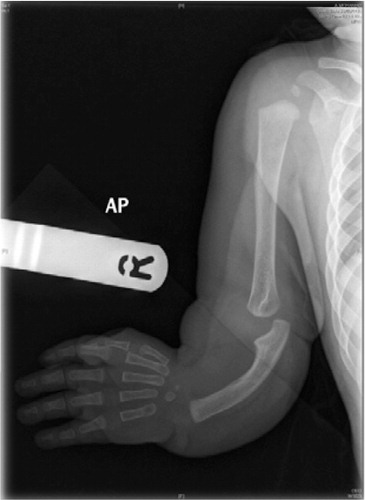Abstract
Congenital radial club hand (RCH) is an uncommon congenital anomaly characterized by various degrees of deficiency along the preaxial or radial side of the extremity. We present one such case of Type 4 congenital isolated RCH who presented to a tertiary care center in the Middle East.
Case presentation
A four-month-old male child was referred for evaluation of right upper limb deformity. He was born at term by normal delivery following an uneventful pregnancy and there was no significant past medical or surgical history. He was the first child of non-consanguineous parents and there was no family history of congenital anomalies. Physical examination of the baby revealed deformity of right forearm which appeared shorter than contra lateral side with radial deviation at the wrist (). All the fingers of the affected hand including the thumb were however normal. Physical examination by our team and by the pediatricians revealed no other abnormalities. Hemoglobin, total and differential leucocytes count, platelet count, and renal function tests were all within normal limits in more than one occasion. Radiographs of both upper limbs revealed complete aplasia of radius and shortening of the ulna on the right side (). Skeletal survey, ultrasonogram of abdomen, and cardiac echocardiogram ruled out any other associated congenital anomalies. The diagnosis of isolated right congenital radial club hand (RCH) Type IV was made and the parents were counseled. The management of the child was started in collaboration with physiotherapists and the family were taught some simple and easily reproducible exercises to passively stretch the radial structures. Custom-made splints were also fabricated by the orthotics division for nocturnal application to the affected limb with the aim of stretching the radial wrist structures. In future, when the level of deformity is deemed optimal for operative intervention (expected by age of one year), operative centralization of the wrist on ulna will be undertaken.
Discussion
Congenital RCH, also called longitudinal radial deficiency or radial dysplasia, is an uncommon congenital anomaly characterized by various degrees of deficiency along the preaxial or radial side of the extremity Citation1. The ulna is typically 60% of normal length. The incidence of RCH is estimated to be 1 in 30,000 to 1 in 100,000 live births Citation2. It is bilateral in 38–58% of cases. Bayne and Klug classified radial deficiency into four types Citation3:
RCH usually occurs sporadically with no known cause. About 40% of patients with unilateral club hand and 27% with bilateral club hand have associated congenital anomalies involving cardiac, genitourinary, skeletal, and hematopoietic system Citation4. The prominent syndromes associated with RCH include: Holt-Oram syndrome; thrombocytopenia-absent radius (TAR) syndrome; vertebral, anal, cardiac, tracheal, esophageal, renal, and limb (VACTERL) syndrome; and Fanconi anemia. The latter is a serious associated condition which usually manifests as aplastic anemia between 3 and 12 years of age.
Correction of RCH requires a combination of non-operative and operative management that should start immediately after diagnosis. Patients should be assessed thoroughly to identify any possible associated anomalies. The basic goals of correction include correction of radial deviation of wrist, balancing the wrist on forearm, maintenance of wrist and finger flexion, promotion of growth of the forearm, and improving the cosmetic appearance of the limb Citation5. The non-operative management comprises of stretching of the taut radial structures by physiotherapy and splintage Citation6. Some centers utilize the appliances based on principles of distraction – osteogenesis (Ilazarov technique) to decrease the magnitude of contracture before definitive surgery Citation7. Operative management aims at centralization of the wrist on the ulna Citation8. Centralization is indicated in RCH Types II, III, and IV. The cases of RCH need to be kept under follow-up upto adulthood to prevent the recurrence of the deformity Citation5, and monitor the function of the affected limb and undertake corrective operative and non-operative interventions as warranted.
Conflict of interest and funding
The authors have not received any funding or benefits from industry to conduct this study.
References
- Goldberg MJ, Meyn M. The radial clubhand. Orthop Clin North Am. 1976; 7: 341–59.
- Urban MA, Osterman LA. Management of radial dysplasia. Hand Clin. 1990; 6: 589–605.
- Waters MP. The upper limb. Lovell and Winters pediatric orthopedics5th ed. Morrissy RT, Weinstein SLLippincott Williams and Wilkins. Philadelphia PA, 2001; 841–903.
- Kozin SH. Upper-extremity congenital anomalies. J Bone Joint Surg Am. 2003; 85: 1564–76.
- Damore E, Kozin SH, Thoder JJ, Porter S. The recurrence of deformity after surgical centralization for radial clubhand. J Hand Surg [Am]. 2000; 25: 745–51.
- Thirkannad SM, Burgess RC. A technique for using the Ilizarov fixator for primary centralization in radial club hand. Tech Hand Up Extrem Surg. 2008; 12: 71–8.
- Goldfarb CA, Murtha YM, Gordon JE, Manske PR. Soft-tissue distraction with a ring external fixator before centralization for radial longitudinal deficiency. J Hand Surg [Am]. 2006; 31: 952–9.
- Manske PR, McCarroll HR Jr, Swanson K. Centralization of the radial club hand: an ulnar surgical approach. J Hand Surg [Am]. 1981; 6: 423–33.

